线程池
线程池
单个请求处理的时间很短,海量请求的情况下,频繁的创建线程,销毁线程所带来的系统开销是巨大的。
- 降低频繁创建、销毁线程的开销、线程的创建和销毁需要 JVM 进行大量的辅助操作。(内存的分配与回收、还会给垃圾回收器带来压力)
- “池”的概念可以很好的防止资源不足。过多线程会占用大量内存,导致 OOM。
- 加快响应速度(复用池中的线程)
- 合理利用 CPU 和内存。
- 统一管理资源。
线程池适用的场景
- 服务器接受到大量请求时,使用线程池技术是非常适合的,它可以大大减少线程的创建和销毁次数,提高服务器的工作效率。
- 5 个以上的线程就可以使用线程池来管理。
不使用线程池(海量任务)
- 线程的创建和销毁需要 JVM 进行大量的辅助操作。(内存的分配与回收、还会给垃圾回收器带来压力)
- 在 Java 语言中每创建一个线程直接对应操作系统中的一个线程。在操作系统中频繁创建、销毁大量线程会造成很大的系统开销。操作系统支持创建的线程数是有上限的。(线程数量无法与未知的任务数量一一对应)
- 无法作用于 C10K 场景,会引发 OOM 异常。
1public class EveryTaskOneThread {
2 public static void main(String[] args) {
3 for (int i = 0; i < 1000; i++) {
4 new Thread(new Task(),"Thread-" + i).start();
5 }
6 }
7
8 static class Task implements Runnable {
9 @Override
10 public void run() {
11 System.out.println(Thread.currentThread().getName() + " 执行了任务");
12 }
13 }
14}
1...
2Thread-924 执行了任务
3Thread-926 执行了任务
4Thread-925 执行了任务
5...
增减线程的时机
线程池构造函数的参数

corePoolSize、maxPoolSize
添加线程规则
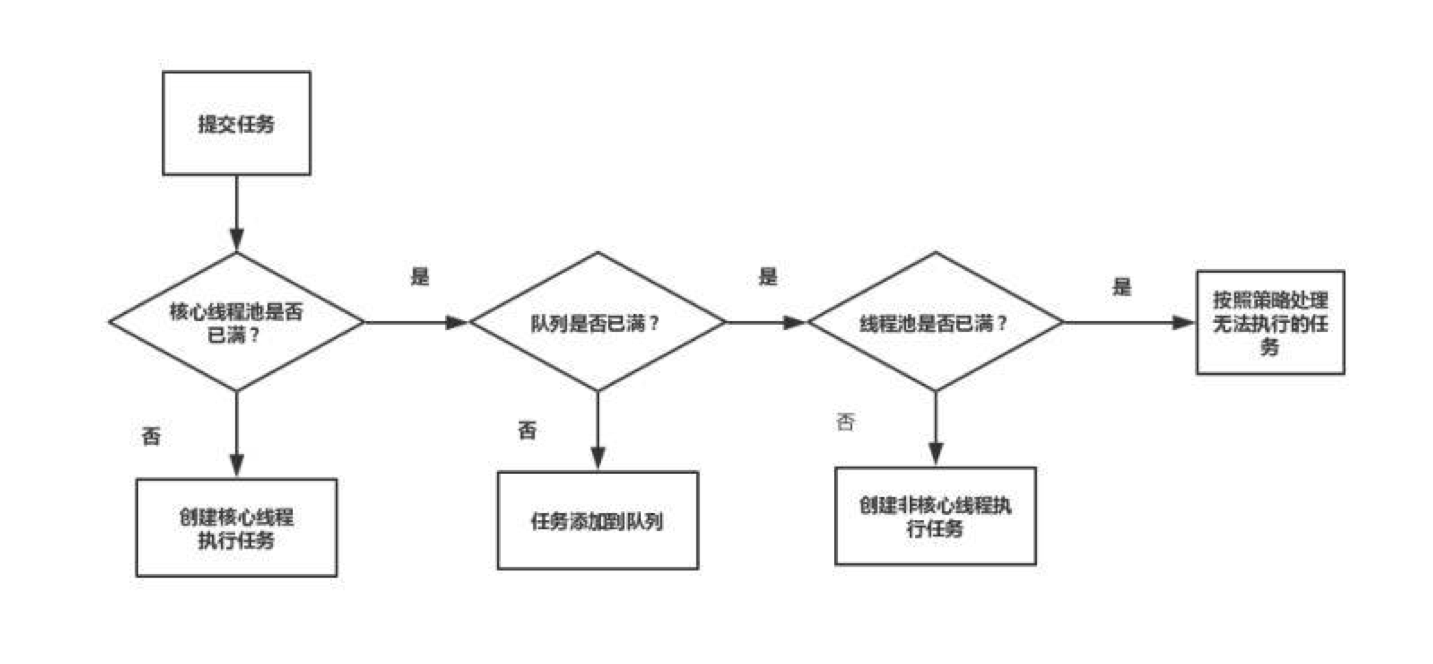
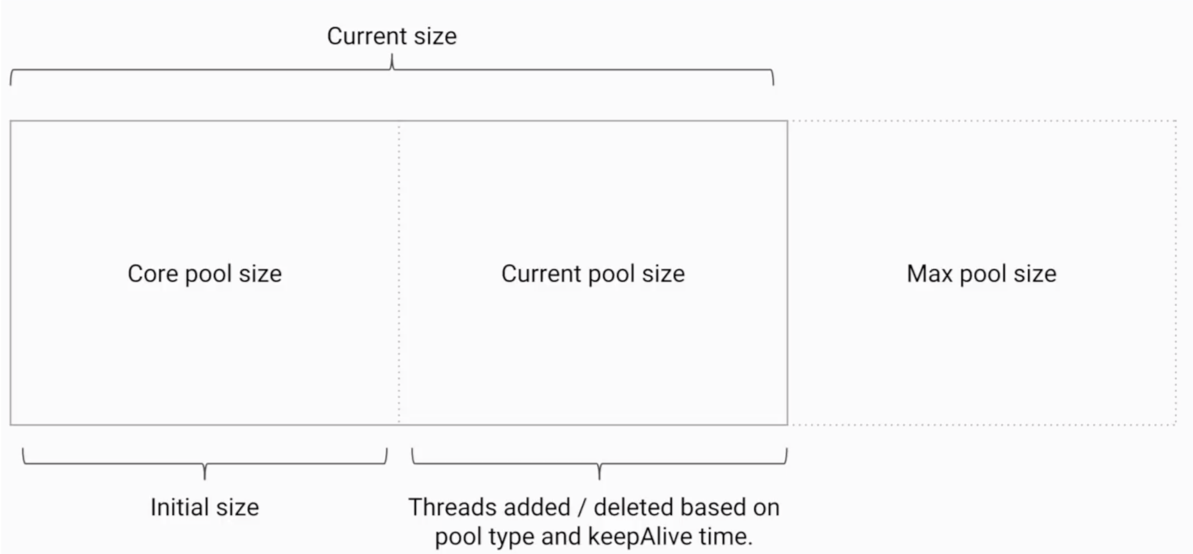
corePoolsize -> workQueue -> maxPoolSize -> deny
11. 如果线程数小于corePoolSize,即使其他工作线程处于空闲状态,也会创建一个新线程来运行新任务。
22. 如果线程数等于(或大于)corePoolSize 但少于 maximumPoolSize,则将任务放入队列。(队列未满,队列已经满,看当前线程是否超过maxPoolSize)
33. 如果队列已满,并且线程数小于maxPoolSize,则创建一个新线程来运行任务。
44. 如果队列已满,并且线程数大于或等于 maxPoolSize,则拒绝该任务。
5
6corePoolsize -> workQueue -> maxPoolSize -> deny
增减线程的特点
- 通过 corePoolSize、maximumPoolSize 相当, 可以创建固定大小的线程池。
- 线程池希望保持较少的线程数,并且只有在负载变得很大时才增加它。
- 通过设置 maximumPoolSize 为很高的值,例如 Integer.MAX_VALUE,可以允许线程池容纳任意数量的并发任务。
- 如果使用误解队列(例如:LinkedBlockingQueue),那么线程数将永远不会超过 corePoolSize。
keepAliveTime 和线程工厂
keepAliveTime
&emps;如果线程池当前的线程多余 corePoolSize,那么如果多余的线程空闲时间超过 keepAliveTime,他们就会被终止。
ThreadFactory
新的线程是由 ThreadFactory 创建的,默认使用 Executors.defaultThreadFactory(),创建出来的线程都在同一线程组,拥有同样的 NORM_PRIORITY 优先级并且都不是守护线程。
如果自己指定 ThreadFactory,那么就可以改变线程名、线程组、优先级、是否是守护线程等。
workQueue
- 直接交换:SynchronousQueue (直接交换不存储,所以 maximumPoolSize 要设置的大一些)
- 无界队列:LinkedBlockingQueue(如果处理的速度跟不上任务提交的速度,那么队列大量积压导致 OOM)
- 有界队列:ArrayBlockingQueue(可以设置队列大小)
线程池创建方式
手动创建更好,因为这样可以让我们更加明确线程池的运行规则,避免资源耗尽的风险。
根据不同的业务场景,自己设置线程池参数,比如内存、自定义线程名等…
自动创建线程池(JDK 封装好的构造函数):演示内存溢出的情况
1import java.util.concurrent.ExecutorService;
2import java.util.concurrent.Executors;
3
4/**
5 * 描述: 演示newFixedThreadPool
6 * VM options: -Xmx8m -Xms8m 把内存调整小一些,模拟OOM发生
7 */
8public class FixThreadPoolTest {
9 public static void main(String[] args) {
10 //底层使用的LinkedBlockingQueue,存在队列堆积OOM的风险。
11 //new ThreadPoolExecutor(nThreads, nThreads,0L, TimeUnit.MILLISECONDS,new LinkedBlockingQueue<Runnable>());
12 ExecutorService executorService = Executors.newFixedThreadPool(2);
13 for (int i = 0; i < Integer.MAX_VALUE; i++) {
14 executorService.execute(new Task());
15 }
16 }
17
18}
19class Task implements Runnable {
20 @Override
21 public void run() {
22 try {
23 System.out.println(Thread.currentThread().getName());
24 Thread.sleep(100000000);
25 } catch (InterruptedException e) {
26 e.printStackTrace();
27 }
28 System.out.println(Thread.currentThread().getName());
29 }
30}
1pool-1-thread-1
2pool-1-thread-2
3Exception in thread "main" java.lang.OutOfMemoryError: GC overhead limit exceeded
4 at java.util.concurrent.LinkedBlockingQueue.offer(LinkedBlockingQueue.java:416)
5 at java.util.concurrent.ThreadPoolExecutor.execute(ThreadPoolExecutor.java:1371)
6 at com.xdclass.couponapp.test.threadpool.FixThreadPoolTest.main(FixThreadPoolTest.java:16)
线程池对比
核心参数对比
| Parameter | FixedThreadPool | CachedThreadPool | ScheduledThreadPool | SingleThreadPool |
|---|---|---|---|---|
| corePoolSize | constructor-arg | 0 | constructor-arg | 1 |
| maxPoolSize | same as corePoolSize | Integer.MAX_VALUE | Integer.MAX_VALUE | 1 |
| keepAliveTime | 0 seconds | 60 seconds | 0 | 0 seconds |
使用队列差异
| FixedThreadPool | CachedThreadPool | ScheduledThreadPool | SingleThreadPool | |
|---|---|---|---|---|
| QueueType | LinkedBlockingQueue | SynchronousQueue | DelayedWorkQueue | LinkedBlockingQueue |
newFixedThreadPool
自定义线程数量,底层使用的 LinkedBlockingQueue,存在队列堆积 OOM 的风险。
ThreadPoolExecutor(nThreads, nThreads, 0L, TimeUnit.MILLISECONDS, new LinkedBlockingQueue<Runnable>());
1 ExecutorService executorService = Executors.newFixedThreadPool(4);
2 for (int i = 0; i < 1000; i++) {
3 executorService.execute(new Task());
4 }
newSingleThreadExecutor
只有一个线程,底层使用的 LinkedBlockingQueue,存在队列堆积 OOM 的风险。
new ThreadPoolExecutor(1, 1, 0L, TimeUnit.MILLISECONDS, new LinkedBlockingQueue<Runnable>()));
1 ExecutorService executorService = Executors.newSingleThreadExecutor();
2 for (int i = 0; i < 1000; i++) {
3 executorService.execute(new Task());
4 }
newCachedThreadPool
可缓存线程池,具有自动回收多余线程的功能。
直接交换线程池(每次请求都要新建线程,相当于没有存储队列),
maximumPoolSize=Integer.MAX_VALUE 相当于无界线程池。
keepAliveTime=60 seconds,具有自动回收多余线程的功能。
return new ThreadPoolExecutor(0, Integer.MAX_VALUE, 60L, TimeUnit.SECONDS, new SynchronousQueue<Runnable>());
1 ExecutorService executorService = Executors.newCachedThreadPool();
2 for (int i = 0; i < 1000; i++) {
3 executorService.execute(new Task());
4 }
newScheduledThreadPool
延迟执行、周期执行相关的线程池。
maximumPoolSize=Integer.MAX_VALUE 有 OOM 的风险。
super(corePoolSize, Integer.MAX_VALUE, 0, NANOSECONDS, new DelayedWorkQueue())
1 ScheduledExecutorService threadPool = Executors.newScheduledThreadPool(10);
2 //延迟5秒
3 //threadPool.schedule(new Task(), 5, TimeUnit.SECONDS);
4 //第一次延迟1秒,然后以周期每3秒钟运行一次
5 threadPool.scheduleAtFixedRate(new Task(), 1, 3, TimeUnit.SECONDS);
newScheduledThreadPool
这个线程池和之前的有很大不同,适合产生子任务的线程(遍历二叉树)。子线程窃取任务(放在子线程自己的队列中,层层窃取,导致无法保证任务的执行顺序。)
JDK1.8 加入。
线程池里的线程数量设置为多少比较合适?
CPU 密集型(加密、计算 hash 等):最佳线程数为 CPU 核心数的 1~2 倍左右。
耗时 IO 型(读写数据库、文件、网络读写等):最佳线程数一般会大于 CPU 核心数很多倍,以 JVM 线程监控显示繁忙情况为依据,保证线程空闲可以衔接上,参考 Brain Goetz 推荐的计算法:
线程数 = CPU核心数 * (1 + 平均等待时间/平均工作时间)
停止线程池的正确方法
- shutdown()
- isShutdown()
- isTerminated()
- awaitTermination()
- shutdownNow()
初始化停止线程池的动作,线程池虽然不一定会立刻停止,但是会拒绝接受新的任务。
1package com.xdclass.couponapp.test.threadpool;
2
3import java.util.List;
4import java.util.concurrent.ExecutorService;
5import java.util.concurrent.Executors;
6import java.util.concurrent.TimeUnit;
7
8/**
9 * 描述: 演示关闭线程池
10 */
11public class ShutDown {
12
13 public static void main(String[] args) throws InterruptedException {
14 ExecutorService executorService = Executors.newFixedThreadPool(10);
15 for (int i = 0; i < 100; i++) {
16 executorService.execute(new ShutDownTask());
17 }
18 Thread.sleep(1500);
19
20 //立刻关闭线程池(暴力)
21 //interrupt正在执行的线程,将队列中的任务以List的形式返回。
22 //返回的任务可以交给新的线程池执行
23 //List<Runnable> runnableList = executorService.shutdownNow();
24 //Thread.sleep(1000);
25 //System.out.println(runnableList.size());
26
27 //让线程池进入停止状态(尝试停止,需要过程)
28 //executorService.shutdown();
29
30 //线程池还在执行,提交新任务会拒绝,报异常
31 //executorService.execute(new ShutDownTask());
32
33 //isShutdown()可以用于判断是否已经进入停止状态了(并不是完全停止所有线程)
34 //System.out.println(executorService.isShutdown());
35
36 //isTerminated()线程池是否已经完全停止
37 //Thread.sleep(10000);
38 //System.out.println(executorService.isTerminated());
39
40 //awaitTermination(time,unit)用来测试在一段时间内线程是否真正的停止
41 //主要作用是检测(如果等待过程中被打断,会抛出InterruptException)
42 //boolean b = executorService.awaitTermination(7L, TimeUnit.SECONDS);
43 }
44}
45
46class ShutDownTask implements Runnable {
47
48 @Override
49 public void run() {
50 try {
51 Thread.sleep(500);
52 System.out.println(Thread.currentThread().getName());
53 } catch (InterruptedException e) {
54 System.out.println(Thread.currentThread().getName() + "被中断了");
55 }
56 }
57}
拒绝新任务
线程池拒绝任务的时机
- 当 Executor 处于关闭状态时,提交新任务会被拒绝。
- 当 Executor 对最大线程和工作对了容量使用有限边界并且已经饱和时。
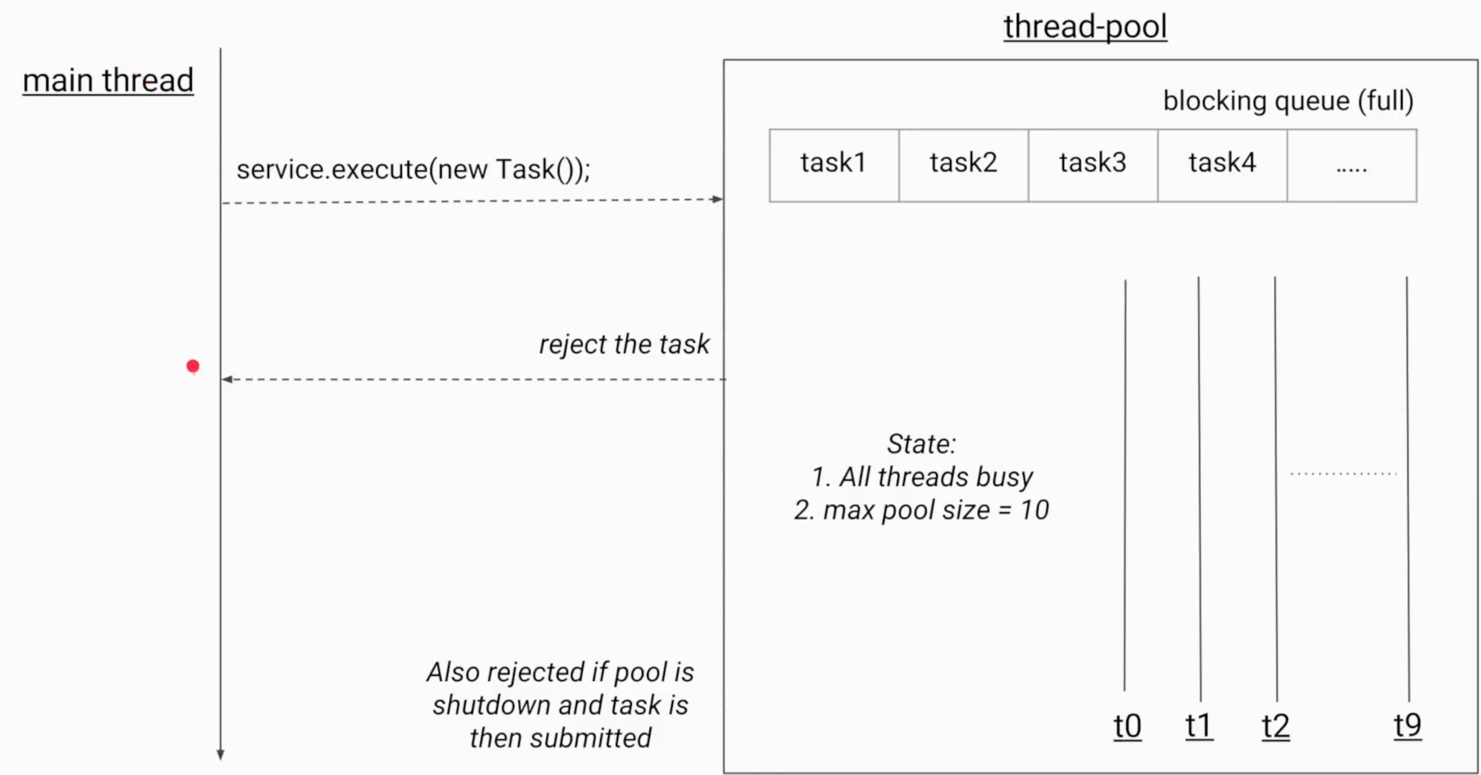
拒绝策略
- AbortPolicy(堕胎):抛出异常
RejectedExecutionException - DiscardPolicy(丢弃):如果线程池无法处理,则会默默丢弃任务,并且不会发出通知。
- DiscardOldestPolicy(弃老):丢弃队列中最老的任务,以便腾出空间存放新提交的任务。
- CallerRunsPolicy(调用者运行):如果线程池无法处理,哪个线程提交的新任务,就由该线程代替执行。
钩子函数:让线程池拥有暂停和恢复能力
- 每个任务执行前后
- 日志、统计
1import java.util.concurrent.BlockingQueue;
2import java.util.concurrent.LinkedBlockingQueue;
3import java.util.concurrent.RejectedExecutionHandler;
4import java.util.concurrent.ThreadFactory;
5import java.util.concurrent.ThreadPoolExecutor;
6import java.util.concurrent.TimeUnit;
7import java.util.concurrent.locks.Condition;
8import java.util.concurrent.locks.ReentrantLock;
9
10/**
11 * 描述: 演示每个任务执行前后放钩子函数
12 */
13public class PauseableThreadPool extends ThreadPoolExecutor {
14
15 private final ReentrantLock lock = new ReentrantLock();
16 private Condition unpaused = lock.newCondition();
17 private boolean isPaused;
18
19
20 public PauseableThreadPool(int corePoolSize, int maximumPoolSize, long keepAliveTime,
21 TimeUnit unit,
22 BlockingQueue<Runnable> workQueue) {
23 super(corePoolSize, maximumPoolSize, keepAliveTime, unit, workQueue);
24 }
25
26 public PauseableThreadPool(int corePoolSize, int maximumPoolSize, long keepAliveTime,
27 TimeUnit unit, BlockingQueue<Runnable> workQueue,
28 ThreadFactory threadFactory) {
29 super(corePoolSize, maximumPoolSize, keepAliveTime, unit, workQueue, threadFactory);
30 }
31
32 public PauseableThreadPool(int corePoolSize, int maximumPoolSize, long keepAliveTime,
33 TimeUnit unit, BlockingQueue<Runnable> workQueue,
34 RejectedExecutionHandler handler) {
35 super(corePoolSize, maximumPoolSize, keepAliveTime, unit, workQueue, handler);
36 }
37
38 public PauseableThreadPool(int corePoolSize, int maximumPoolSize, long keepAliveTime,
39 TimeUnit unit, BlockingQueue<Runnable> workQueue,
40 ThreadFactory threadFactory, RejectedExecutionHandler handler) {
41 super(corePoolSize, maximumPoolSize, keepAliveTime, unit, workQueue, threadFactory,
42 handler);
43 }
44
45 @Override
46 protected void beforeExecute(Thread t, Runnable r) {
47 super.beforeExecute(t, r);
48 lock.lock();
49 try {
50 while (isPaused) {
51 unpaused.await();
52 }
53 } catch (InterruptedException e) {
54 e.printStackTrace();
55 } finally {
56 lock.unlock();
57 }
58 }
59
60 @Override
61 protected void afterExecute(Runnable r, Throwable t) {
62 super.afterExecute(r, t);
63 }
64
65 private void pause() {
66 lock.lock();
67 try {
68 isPaused = true;
69 } finally {
70 lock.unlock();
71 }
72 }
73
74 public void resume() {
75 lock.lock();
76 try {
77 isPaused = false;
78 unpaused.signalAll();
79 } finally {
80 lock.unlock();
81 }
82 }
83
84 public static void main(String[] args) throws InterruptedException {
85 PauseableThreadPool pauseableThreadPool = new PauseableThreadPool(10, 20, 10l,
86 TimeUnit.SECONDS, new LinkedBlockingQueue<>());
87 Runnable runnable = new Runnable() {
88 @Override
89 public void run() {
90 System.out.println("我被执行");
91 try {
92 Thread.sleep(10);
93 } catch (InterruptedException e) {
94 e.printStackTrace();
95 }
96 }
97 };
98
99 for (int i = 0; i < 10000; i++) {
100 pauseableThreadPool.execute(runnable);
101 }
102
103 Thread.sleep(1500);
104 pauseableThreadPool.pause();
105 System.out.println("线程池被暂停了");
106 Thread.sleep(1500);
107 pauseableThreadPool.resume();
108 System.out.println("线程池被恢复了");
109
110 }
111}
线程池的实现原理
线程池组成部分
- 线程池管理器
- 工作线程
- 任务队列
- 任务接口(Task)
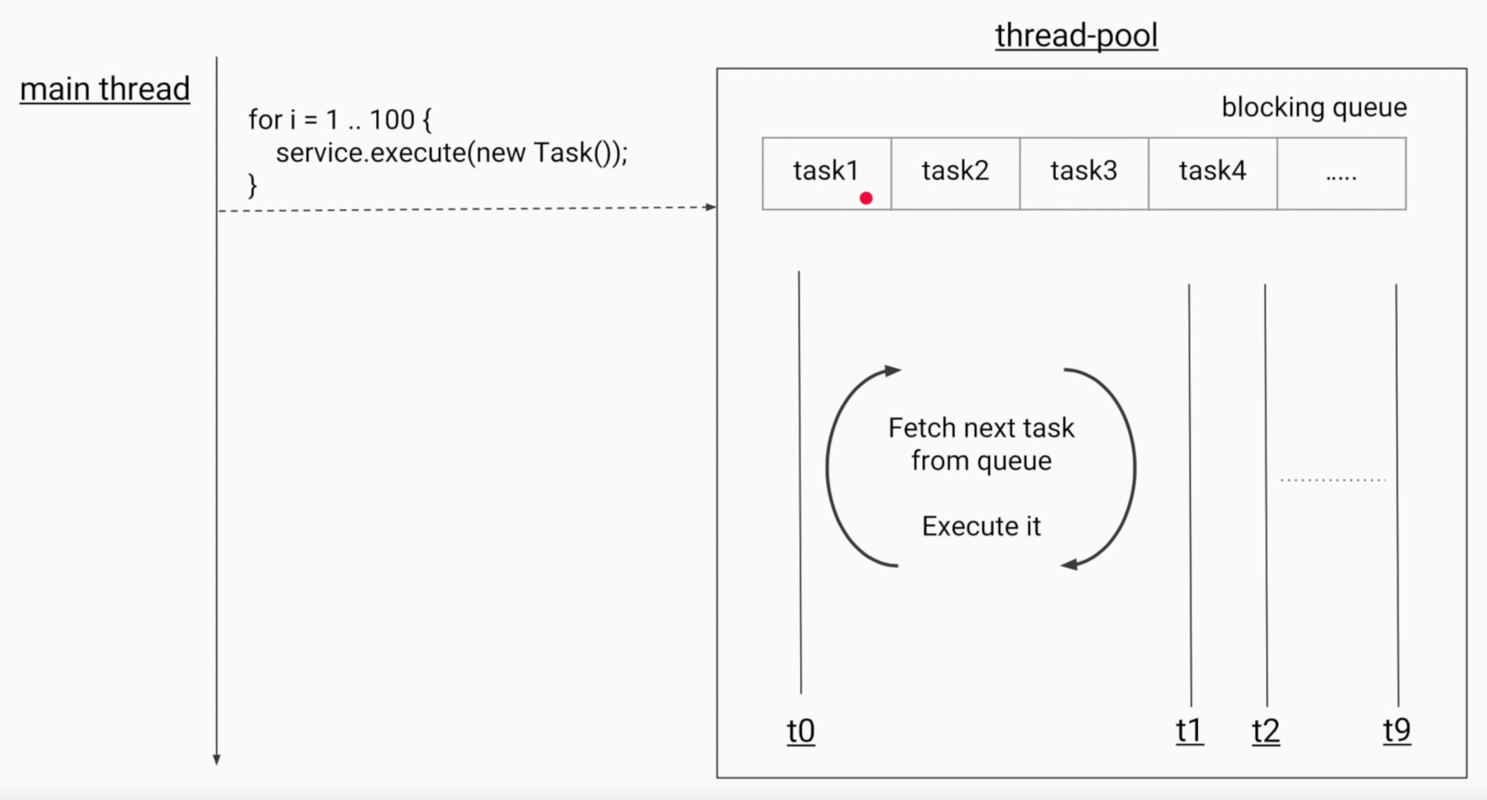
ThreadPoolExecutor、ExecutorService、Executor、Executors 之间的关系
一般把 ExecutorService 看作是线程池。
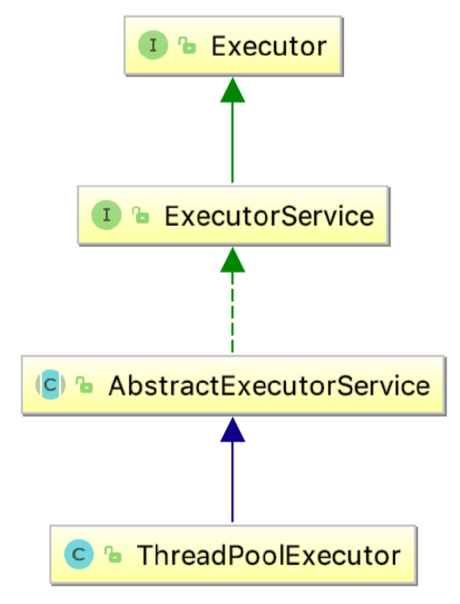
- Executor:顶层接口,只有一个方法
void execute(Runnable command); - ExecutorService:继承 Executor 接口,并且增加了一些新的方法。
- ThreadPoolExecutor:子类(底层实现类)
- Executors:是一个工具类
线程池实现任务复用的原理
- 相同线程执行不同任务(线程池对线程做了包装,不需要重复的启动线程,只启动哪些 corePoolSize 的线程,后续的任务复用已有线程)
1 final void runWorker(Worker w) {
2 Thread wt = Thread.currentThread();
3 Runnable task = w.firstTask; //从阻塞队列拿到任务
4 w.firstTask = null;
5 w.unlock(); // allow interrupts
6 boolean completedAbruptly = true;
7 try {
8 while (task != null || (task = getTask()) != null) { //只要任务不为空,循环判断
9 w.lock();
10 // If pool is stopping, ensure thread is interrupted;
11 // if not, ensure thread is not interrupted. This
12 // requires a recheck in second case to deal with
13 // shutdownNow race while clearing interrupt
14 if ((runStateAtLeast(ctl.get(), STOP) ||
15 (Thread.interrupted() &&
16 runStateAtLeast(ctl.get(), STOP))) &&
17 !wt.isInterrupted())
18 wt.interrupt();
19 try {
20 beforeExecute(wt, task);
21 Throwable thrown = null;
22 try {
23 task.run(); //运行任务
24 } catch (RuntimeException x) {
25 thrown = x; throw x;
26 } catch (Error x) {
27 thrown = x; throw x;
28 } catch (Throwable x) {
29 thrown = x; throw new Error(x);
30 } finally {
31 afterExecute(task, thrown);
32 }
33 } finally {
34 task = null;
35 w.completedTasks++;
36 w.unlock();
37 }
38 }
39 completedAbruptly = false;
40 } finally {
41 processWorkerExit(w, completedAbruptly);
42 }
43 }
线程池状态
- RUNNING:接受新任务并处理排队任务。
- SHUTDOWN:不接受新任务,但处理排队任务。
- STOP:不接受新任务,也不处理排队任务,并中断正在进行的任务。
- TIDYING:中文是整洁,所有任务都已终止, workerCount 为零时,线程会转到 TIDYING 状态,并将运行 terminate() 钩子方法。
- TERMINATED:terminate() 运行完成。
线程池的注意点
- 避免任务堆积:无解的队列会导致 OOM
- 避免线程数过渡增加:cachedThreadPool,每来一个任务就要创建一个线程。
- 排查线程泄漏:线程已经执行完毕,却不能被回收。